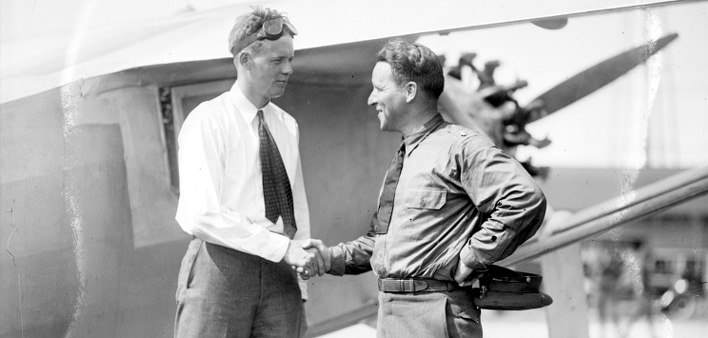(from Summer, 2014 Macomb Now Magazine)
By Denis LeDuc
It was a heady age, the 1920s! The Doughboys were home, factories were humming, the stock market and hemlines were rising, and the ebullient strains of jazz filled the streets. Young, vigorous Americans thought they could accomplish anything, and so did an obscure U.S. Postal Service pilot flying the airmail route from St. Louis to Chicago
Pioneer aviator Charles A. Lindbergh was born Feb. 4, 1902 in Detroit and raised on a Minnesota farm. He studied mechanical engineering at the University of Wisconsin but grew bored and left to pursue his dream of flight.
Lindbergh taught himself to fly and, with a World War 1 surplus Curtis Jenny biplane he purchased for $500, he toured the West as a barnstorming pilot, entertaining crowds with aerial acrobatics, wing walking and parachuting.
Neither rain, nor sleet, nor snow could deter the delivery of the U.S. Mail, and that included airmail. Flying in sometimes horrible weather, Lindbergh crashed two U.S. Postal Service planes, parachuting to safety in farmers’ field. Each time he recovered the mail and successfully delivered it to its destination. In the U.S. Army Air Corps Reserve, Capt. Charles A. Lindbergh built such a reputation that he was able to convince a group of St. Louis businessmen to financially back his proposed attempt to be the first to successfully fly the Atlantic nonstop. At least six previous aviators had lost their lives attempting the same feat.
Taking off into bad weather on May 20, 1927 from Roosevelt Field on Long Island, in a Ryan Monoplane he had helped design, Lindbergh flew steadily east for 33.5 numbing hours, fighting fatigue. Sometimes he flew at 10,000 feet above the icy storm clouds and sometimes at no more than 10 feet above the ocean waves.
Navigating by the few stars he could glimpse but often only by dead reckoning, “Lucky Lindy” miraculously found the lights (actually the headlamps of hundreds of French automobiles parked to illuminate the runways) of Le Bourget Field outside Paris. Thousands of Frenchmen had gathered to greet him as word spread quickly that he had crossed the French coast. Lindbergh was pulled from his plane and hosted to the shoulders of the jubilant crowd. The previously obscure mail pilot was now the toast of New York, Paris, London – and of Selfridge Field.
In the July 1, 1927 Detroit News photo above, “Lucky Lindy,” left, had returned to Selfridge Field where he had been stationed in 1924. He was greeted by Major Thomas G. Lanphier, his friend and Selfridge field commander. The Spirit of St. Louis is seen in the background. Although Lindbergh seldom allowed anyone else to pilot the plane, he let his former Commander fly the Spirit of St. Louis above the Field, much to the delight of the throngs below.
The Selfridge Military Air Museum is open to the public on weekends from April through October.
For more information, or to volunteer or donate, visit selfridgeairmuseum.org, email [email protected] or call 5986-239-5035
Photo courtesy of Walter P. Reuther Archive of Labor and Urban Affair, Wayne State University.


